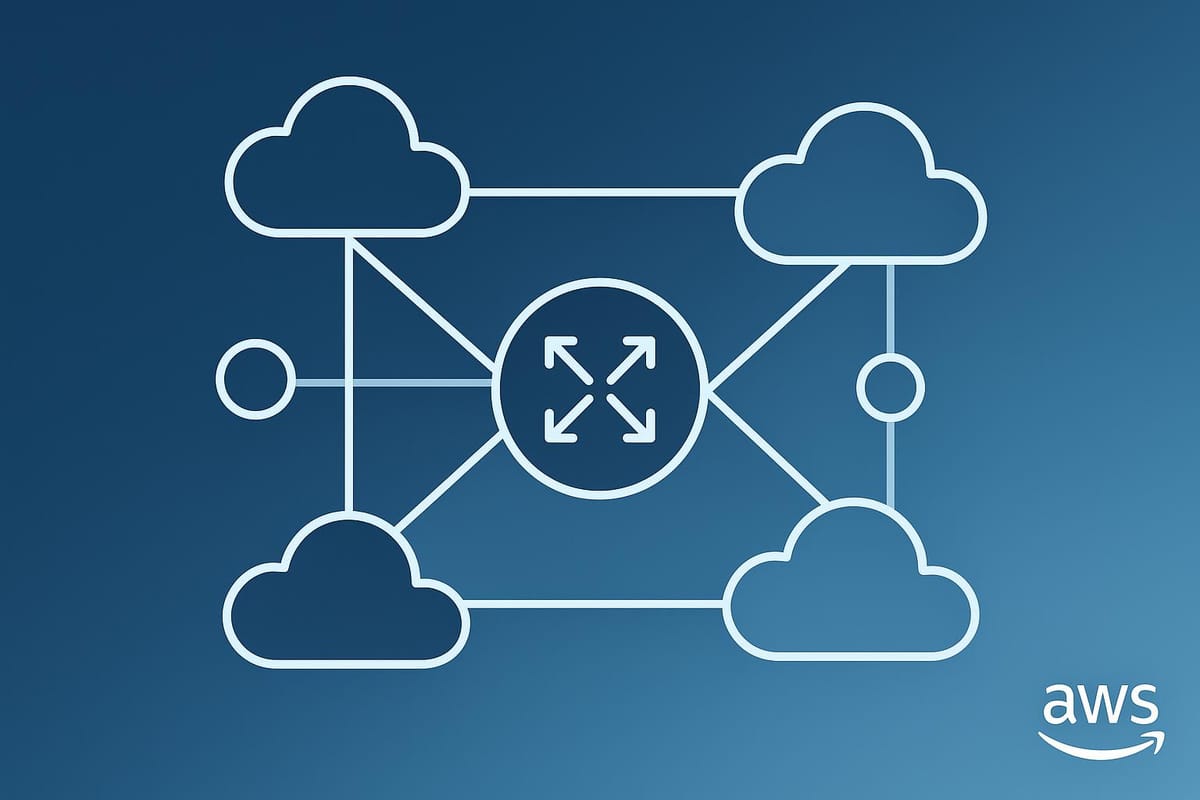Best Practices for Cross-Region Data Transfer with Transit Gateway
Streamline your cross-region data transfer with AWS Transit Gateway, optimising costs, performance, and scalability for your network.

AWS Transit Gateway makes cross-region data transfer simpler, faster, and more cost-effective. By acting as a central hub, it removes the complexity of managing multiple direct connections between VPCs and regions. Here's what you need to know:
- Cost Efficiency: Reduce expenses by consolidating connections, using inter-region peering, and optimising data transfer routes. AWS charges £0.02–£0.17 per GB for inter-region transfers, so careful planning can save you money.
- Performance: Inter-region peering ensures low-latency, secure data transfer over AWS's private backbone network, bypassing the public internet. Features like load balancing and route optimisation further improve speed and reliability.
- Scalability: Transit Gateway supports thousands of VPCs and VPNs, making it ideal for growing businesses. Use unique Autonomous System Numbers (ASNs) and one Transit Gateway per region to future-proof your setup.
- Monitoring: Tools like CloudWatch, Transit Gateway Flow Logs, and Cost Explorer help track performance and expenses, ensuring your network stays efficient.
Quick Tip: Keep traffic within the same region whenever possible to minimise transfer costs and latency. Use compression, caching (e.g., Amazon CloudFront), and Direct Connect for large-scale data transfers to save even more.
Transit Gateway simplifies multi-region AWS setups, reduces costs, and ensures your network is ready to scale as your business grows.
EC2 cross-region Transit Gateway peering connection 2024 | Hands-On - AWS tutorial
What is AWS Transit Gateway and How Does It Handle Cross-Region Data Transfer

AWS Transit Gateway acts as a central hub connecting your VPCs and on-premises networks through a hub-and-spoke model. This approach simplifies network management by removing the need for multiple direct, point-to-point connections, making it easier to oversee and scale your network.
When it comes to cross-region data transfer, Transit Gateway uses inter-region peering. This involves creating a direct routing path between transit gateways in different regions. For example, data moving between London and Frankfurt travels securely over AWS's global backbone, bypassing the public internet entirely. At the technical level, Transit Gateway operates at layer 3, directing packets based on their destination IP addresses. Additionally, all traffic between AWS data centres is encrypted at the physical layer, ensuring security. Below, we’ll explore some of the key features that make this service effective.
Key Features of AWS Transit Gateway
AWS Transit Gateway offers a range of features designed to improve cross-region connectivity:
- Elastic scalability: The service adjusts dynamically to match network traffic demands, ensuring smooth performance even as usage grows.
- Inter-region peering: This is established through peering attachments, which require approval from the destination gateway owner. Once set up, static routes efficiently manage traffic flow.
- Broad attachment support: Transit Gateway supports connections for VPCs, VPNs, AWS Direct Connect gateways, Transit Gateway Connect attachments, and peering connections. This flexibility accommodates various network setups.
- Dual-protocol support: Both IPv4 and IPv6 traffic are supported.
- High bandwidth: Each Connect attachment can deliver up to 20 Gbps of total bandwidth.
- Strong encryption: AES-256 encryption secures data at both the virtual network layer and the physical layer, particularly when data crosses links outside AWS's physical infrastructure.
These features make AWS Transit Gateway a reliable choice for handling complex networking needs while maintaining robust data security.
Benefits of Using Transit Gateway for SMBs
For small and medium-sized businesses (SMBs), AWS Transit Gateway offers several practical advantages. Its centralised management model simplifies operations by consolidating numerous direct peering connections into a single gateway. This reduces the time and effort IT teams spend on managing individual connections, allowing them to focus on more strategic tasks.
Scalability is another standout benefit. Transit Gateway supports thousands of VPCs and VPN connections, which means businesses can expand their networks without needing to overhaul their entire setup. By centralising network resources, SMBs can also cut down on attachment costs.
Additionally, integration with Amazon CloudWatch provides valuable monitoring and insights, helping businesses optimise their resource use and network performance. All of these capabilities make AWS Transit Gateway a cost-effective and efficient solution for SMBs looking to streamline their network infrastructure.
Best Practices for Cross-Region Data Transfer
Balancing performance, cost, and reliability is key when managing cross-region data transfer.
Use Inter-Region Peering for Low-Latency Connectivity
Inter-region peering provides fast and secure connections between AWS regions by creating direct routing paths between transit gateways, keeping data off the public internet. For instance, Autodesk managed to cut cloud routing latency from 60 milliseconds down to just 2 milliseconds by using AWS Transit Gateway with a transit VPC setup.
When configuring inter-region peering, it's wise to keep traffic within the same region whenever feasible. This not only minimises latency but also avoids extra charges for inter-region data transfers. To further improve performance, distribute the traffic load evenly across available connections.
Implement Load Balancing Across Connections
AWS Transit Gateway leverages Equal Cost Multipath (ECMP) routing for most attachments, ensuring traffic is automatically spread across multiple paths. It also considers both source and destination Availability Zones when routing, which boosts efficiency and reduces delays.
For small and medium-sized businesses, effective load balancing helps cut down operational complexities and avoids creating redundant connections. To make the most of load balancing, avoid setting up duplicate connections between the same regions, as this can lead to unnecessary costs. This approach keeps your network flexible and cost-efficient.
Monitor and Improve Network Performance
Setting up your network is just the beginning - ongoing monitoring is crucial to maintain optimal performance. AWS Transit Gateway Flow Logs capture detailed traffic data, helping you identify issues and streamline data flow.
Pair these logs with Amazon Managed Grafana for quick visualisation and analysis by storing them in Amazon S3. Additionally, the AWS Transit Gateway Network Manager Route Analyzer can diagnose network problems by validating routes in your Transit Gateway route table and flagging incomplete paths that might disrupt performance.
For real-time insights, Amazon CloudWatch offers metrics on traffic throughput, latency, and error rates. With per-Availability Zone metrics, you can gain a detailed view of traffic patterns and performance. Regular monitoring routines are essential to catch and resolve issues early, and analysing traffic patterns can help you eliminate unnecessary data transfers, improving both performance and cost efficiency.
Cost Considerations for Cross-Region Data Transfer
Managing the costs of cross-region data transfer is an essential task for SMBs aiming to optimise their AWS spending while maintaining strong performance.
Data Processing and Transfer Charges
AWS Transit Gateway uses a straightforward pricing structure with three main components: an hourly charge of £0.05 per VPC attachment, a £0.02 per GB fee for data processing, and a £0.02–£0.17 per GB charge for data transfer, depending on the regions involved.
For businesses that handle large volumes of data, these expenses can quickly add up. Larger enterprises, in particular, often face hefty fees, which makes cost management a priority even for well-established organisations. Additionally, Site-to-Site VPN connections are billed at £0.05 per hour, with partial hours rounded up and charged as full hours.
To stay on top of these costs, SMBs can use AWS Cost Explorer alongside cost allocation tags. These tags, when applied to instances and load balancers, provide detailed insights into spending. They are particularly useful in multi-account setups, helping teams or projects monitor Transit Gateway data processing charges more effectively. To start tracking expenses this way, activate cost allocation tags in the AWS Billing Console.
Now, let’s look at how you can tweak your setup to minimise these costs.
Strategies to Reduce Costs
Balancing performance with cost efficiency is key to building a scalable and sustainable network. Start by auditing your Transit Gateway configuration. Remove unused Transit Gateway attachments to avoid unnecessary charges. Use Transit Gateway route tables to control traffic flow and prevent data processing costs from non-essential communication between VPCs.
Streamlining your architecture can also lead to savings. Try to keep your applications within as few regions as possible and, when possible, select regions with lower data transfer rates. Deploying resources within the same availability zone is another effective strategy, as it eliminates inter-availability zone (inter-AZ) transfer costs entirely.
"Traffic that crosses an Availability Zone boundary typically incurs a data transfer charge. Use resources from the local Availability Zone whenever possible." – AWS Architecture Blog
Using Amazon CloudFront can save 20–40% on data transfer costs compared to standard AWS rates. CloudFront’s caching capabilities also improve user experience by reducing repeated data transfers.
Another practical tip is to compress data to reduce transfer volumes, which directly lowers costs. For large-scale transfers, Amazon Direct Connect is worth exploring. It can reduce transit times and avoid internet congestion, often making it a more cost-effective option than standard internet-based transfers. Additionally, VPC gateway endpoints allow intra-region communication with Amazon S3 and Amazon DynamoDB without incurring data transfer charges. For inter-region traffic, cross-region VPC peering is often cheaper than using Transit Gateways, making it a good alternative for certain scenarios.
AWS also offers tools to help manage expenses. AWS Budgets can send alerts if data transfer costs exceed your set thresholds, while AWS Trusted Advisor highlights potential cost-saving opportunities. Regularly reviewing your application’s data flow is another essential step. Identifying and eliminating unnecessary transfers can help you refine your architecture and keep costs under control.
How to Ensure Scalability and Reliability with Transit Gateway
Creating a network that can expand alongside your business requires thoughtful preparation. The foundation you establish today should be capable of supporting future growth and changes.
Use Different Autonomous System Numbers (ASNs)
One of the smartest ways to prepare your network for future needs is by assigning unique ASNs to each peered Transit Gateway. This approach ensures flexibility, especially as AWS continues to develop new routing features. Currently, BGP route propagation between regional Transit Gateways isn’t available, but AWS advises using distinct ASNs to stay ready for upcoming updates.
When deploying multiple Transit Gateways, make sure each one has a unique ASN. This prevents routing conflicts and gives you better control over traffic flow between regions. For example, assign a unique ASN to each regional Transit Gateway during its creation. AWS makes it simple by allowing you to specify an ASN in the configuration. You can use private ASNs (64512–65534) or request a public ASN if required. Keep a record of all ASNs to maintain consistent management across regions.
By combining this practice with regional consolidation, you’ll establish a solid framework for a scalable and reliable network.
Set Up One Transit Gateway Per Region
To streamline your network, deploy one Transit Gateway per region. This approach simplifies routing, reduces complexity, and improves recovery times. Acting as the central hub for all regional connectivity, a single Transit Gateway per region helps centralise monitoring and management. For instance, you can use CloudWatch to track and manage traffic flow efficiently.
This setup also makes troubleshooting easier by reducing potential points of failure, which in turn speeds up recovery. Additionally, Transit Gateway Insights provides detailed visibility into data flow, helping to identify any delays or bottlenecks.
For an effective implementation, configure each Transit Gateway in a central account. Enable auto-acceptance for both associations and propagation, and share the Transit Gateway across your organisation using AWS Resource Access Manager. To boost reliability, consider using Equal-Cost Multi-Path (ECMP) routing, which distributes traffic across multiple paths to enhance both bandwidth and redundancy.
Regular disaster recovery testing is crucial to ensure your setup is prepared for emergencies. AWS suggests an incremental approach to automation, particularly when setting up automated responses. Use CloudWatch alarms with anomaly detection to spot unusual conditions, but be cautious with automated failovers to avoid disrupting all connections at once.
Conclusion and Key Takeaways
AWS Transit Gateway offers a straightforward way for small and medium-sized businesses (SMBs) to manage cross-region data transfers. By centralising network architecture, it eliminates the hassle of handling multiple individual connections, providing a scalable solution that adapts to future needs.
This streamlined approach doesn't just simplify management - it also helps cut costs. With Transit Gateway, businesses can reduce data processing expenses while lowering the overhead tied to managing complex networks.
Supporting thousands of VPCs and VPN connections, Transit Gateway lays the groundwork for seamless growth. Following best practices, like assigning unique ASNs and deploying one Transit Gateway per region, ensures your network is ready to expand without needing major overhauls.
Security gets a boost too, thanks to built-in inter-region peering encryption on AWS’s global private network. The centralised setup allows for consistent security policies across your connections, which is especially helpful for SMBs without dedicated network security teams.
To maximise these benefits, start by consolidating site-to-site VPN connections and integrating development environments with shared infrastructure services. Use tools like AWS Cost Explorer and implement a robust tagging strategy to monitor your network's financial and operational performance.
By adopting Transit Gateway, you create a network infrastructure that's not only easier to manage but also secure and scalable. This makes it an essential tool for SMBs aiming to build a resilient, multi-region AWS setup. Investing in the right configuration today can save time, reduce costs, and prepare your business for future growth.
For more tips on optimising AWS infrastructure for your business, visit AWS for SMBs. You'll find expert advice designed specifically to help SMBs navigate cloud adoption effectively.
FAQs
How does AWS Transit Gateway's inter-region peering enhance the security of transferring data between regions?
AWS Transit Gateway's inter-region peering boosts security by ensuring that all data moving between regions is encrypted and stays within the AWS global network. This setup removes the need for data to travel over the public internet, cutting down the chances of interception or tampering.
By keeping traffic limited to AWS's private infrastructure, it provides an extra layer of protection against external threats, making cross-region data transfers both safe and dependable.
How can I reduce costs when using AWS Transit Gateway for large-scale cross-region data transfers?
To cut costs with AWS Transit Gateway for large-scale cross-region data transfers, focus on reducing inter-region traffic. One effective way to do this is by consolidating workloads within the same region whenever possible. This approach helps eliminate the need for costly cross-region data transfers.
Another key strategy is to streamline your network architecture. Avoid unnecessary data flows and adopt efficient data access methods. For instance, using Gateway Endpoints to access AWS services can help you sidestep data transfer fees. Regularly analysing and adjusting your data transfer patterns can also lead to better cost management.
For small and medium-sized businesses, implementing these strategies can help lower expenses without compromising on performance or reliability.
Why should each Transit Gateway use a unique Autonomous System Number (ASN), and how does this benefit network scalability?
When setting up your Transit Gateway, assigning a distinct Autonomous System Number (ASN) to each one is crucial for ensuring smooth and organised routing. This enables you to create specific routing policies, reducing the chances of conflicts and making network management more straightforward as your infrastructure expands.
This method supports the growth of your network by accommodating more intricate architectures. It also optimises BGP routing and improves fault isolation, making it simpler to scale across different regions without affecting your current setup.




